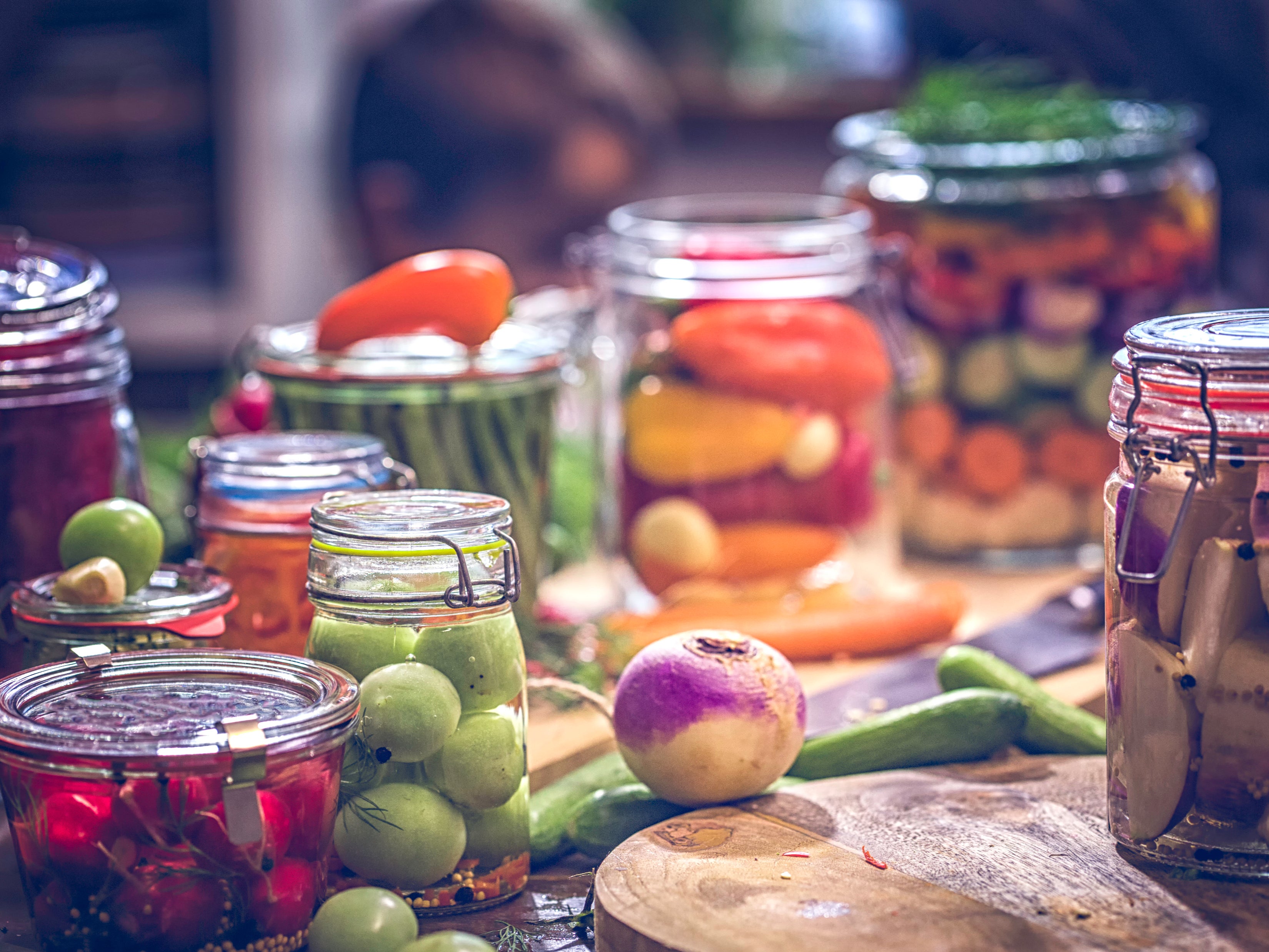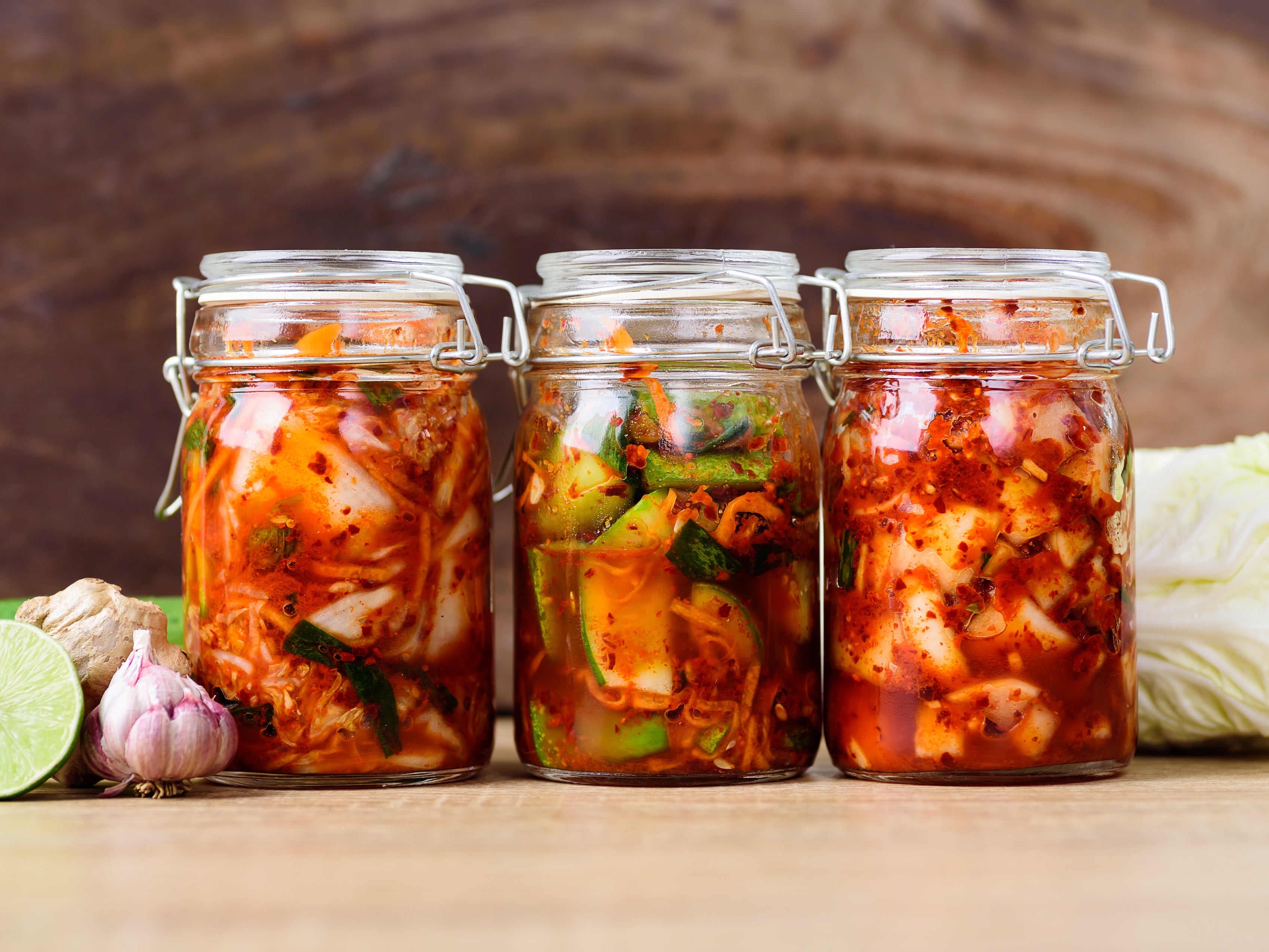The simple food trick which helps with weight loss and mental health
We all know fermented food is good for our gut microbiome, but making it yourself can supercharge your health in unexpected ways, says Karen Gray. The self-confessed ‘kimchi queen’ says fermenting is as satisfying as baking and gardening…

Standing at my kitchen counter, I can hear the effervescent popping and pinging of air bubbles in my water kefir. In this one single jar, lives a community of microbacteria that I have nurtured for about three years. It was gifted to me by a doctor friend – I was her “first successful transplant”; her other kefir grain gifts didn’t survive.
By religiously feeding the right food to the grains and creating an environment for it to thrive, I now make one bottle of water kefir every week. Next to the kefir jar, are other jars of kombucha, kraut and kimchi.
These “four Ks” appear to supercharge gut bacteria, boosting physical and mental health.
Professor Tim Spector, one of the most fervent champions of the microbiome diet, advises we eat at least 30 different types of plants each week and consume fermented foods instead of ultra-processed foods, which have a detrimental effect on our gut.
According to a Stanford University study, a fermented-food diet increases immunity and overall health, helping with weight maintenance as well as decreasing the risk of diabetes, cancer and cardiovascular disease. Often dubbed the body’s “second brain”, bad gut health has also been linked to depression and low mood.
The “gut-pound” has brought a payday to some. Supermarket shelves now heave under the weight of cans of kombucha, kefir and gut shots. Drinking a £2.50 gut shot daily would mean parting with nearly £1,000 a year and that’s before factoring in the £10 jar of kimchi, the £5 tub of miso and the £3 bottle of kombucha. But the good news is that it’s easy to live a fermenting lifestyle without breaking the bank. It also doesn’t have to be complicated.
“Making a sauerkraut doesn’t take much longer than making a salad with salad dressing,” says Asa Linea Simonsson, a registered nurse and nutritional therapist and fermentation specialist. All it takes is chopping up some cabbage, massaging it with salt, leaving it for a minute and putting it in a jar. This is known as wild fermentation where we rely on the microbes naturally found on foods or in the air to kickstart the fermentation process.
Sauerkraut undergoes lacto-fermentation, which is where the nutrients are kept intact and even generate new ones like B vitamins and vitamin K. “It’s changing the flavour and the texture to become something completely different,” says Simonsson.
After the preparation, the jar needs to be left for a few weeks at room temperature and kept out of direct sunlight. During this wait, anything from two to six weeks, the jars will need to be “burped” – as simple as opening the lid so the carbon dioxide that has built up is released.

When you consider that fermentation dates back to 10,000BC – you can see how this is a time-tested process that humans have used in their diets for thousands of years. It is a reminder that we are as much a part of nature as the soil and sky.
As Dr Emily Leeming, a registered dietitian and microbiome scientist at King's College London, explains, “They’re in the air you breathe, in soil, on animals and the skin of other humans and on every surface. We touch our faces and our mouths multiple times a day so many friendly and harmless bacteria are naturally entering our gut throughout the day.”
Probiotic micro-organisms like Mycobacterium vaccae, a bacterium found in soil, appears to aid the release of the chemical serotonin, which may alleviate anxiety and depression.
Jelena Belgrave, a fermentation educator and consultant, has a fermenting repertoire that includes koji, kraut, hot sauce and vinegar. She worked out a way to slot her fermenting into her day, keeping her jars next to her kettle. When she’s making a cup of tea, it reminds her to check her ferments and burp them.
When her son was prescribed antibiotics recently, she supplemented his probiotics with some fermented foods, including water kefir, because the recovery of the gut microbiome can take between five to 10 days to recover after a short course. “Live and unpasteurised foods like kefir and fermented vegetables can provide beneficial probiotic bacteria that can survive gastric acids,” she says.

Fermenting can help reduce food waste too; vegetable peel can be transformed into a vinegar pickle with sauce, old sauerkraut dehydrated and ground up to use as seasoning. If we all did our little bit by fermenting our way through vegetable offcuts we could make a dent in the staggering 9.5 million tonnes of food we throw away every year in the UK.
Our modern consumption-driven lifestyle is at the root of much of our disconnection from nature and the environment, but without expiry dates on vegetables, instead of feeling lost and discombobulated, you can feel liberated.
And unlike baking, the process doesn’t have to be precise. “You can play around with the amount of ingredients,” says Pao, who grew up in Taipei City, but has been based in London since age 21.
Eating preserved foods is part of the culture in Taiwan, but it has only been in the last 12 years that she has learnt about making them herself. Her artisan business, Pao Pop N Pickles, hosts fermenting workshops and she is still learning how every culture has its own “culture”; its own stories.
In countries with cold climates, fermentation takes place in the winter. But in countries with hotter climates, the fermenting process can include drying out the ingredients in the sun so that the food can be kept throughout summer. Belgrave, who grew up in the Balkans, has childhood memories of seeing whole cabbage heads, with added juniper berries or caraway seeds. in the brine.

The cabbage heads are used for cooking, as well as eaten raw. The fermented brine can be used for another batch of vegetables, or in a vinaigrette. Or it can be kept in the fridge and used as a gut shot – drink 10 to 15ml every morning. Drinking on an empty stomach means a faster absorption of the nutrients.
While fermenting has helped Belgrave and Pao reconnect with their culture, for them fermenting can also be a communal practice. Together with two friends, they have created the Ladies Who Ferment collective based in east London.
One of the friends is getting married, and they all came together to make miso from soya beans and koji rice (cooked rice that is inoculated with a fermentation culture called Aspergillus oryzae). It will be left alone for at least six months. Then “we’re going to give it as a wedding present, which I think [has] got so much symbolism and meaning, because we made it together”, says Belgrave.
Fermenting also activates the senses – smell, touch and taste. Like gardening, it is an act of care and nurture. I have been doing it for four years, and each time I engage with a huge amount of intention: setting aside the time to do it, honouring nature’s gifts, while showing respect for the environment and the health of my family.
I enjoy the mindfulness of adjusting to a wilder passage of time, not one dictated by the 24-hour clock. Instead of rushing, fermenting is about going at nature’s pace and we all need more of that in our packed days.






Join our commenting forum
Join thought-provoking conversations, follow other Independent readers and see their replies
Comments